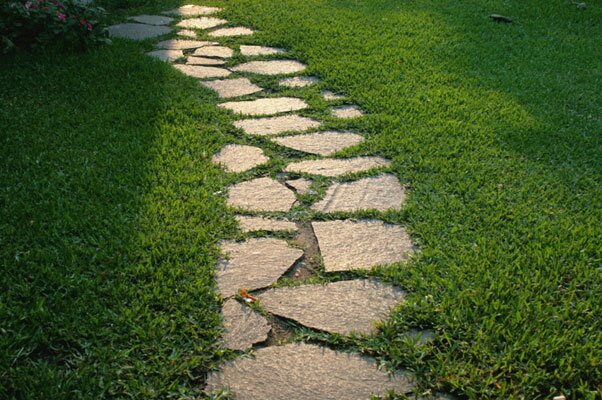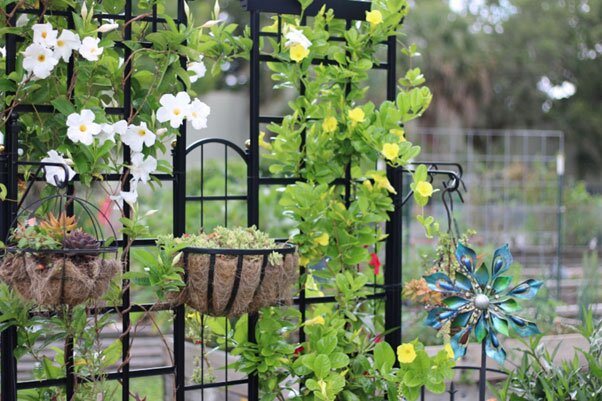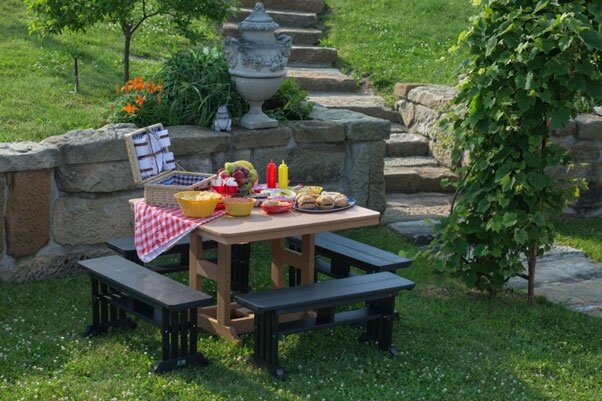Whether you have a long, narrow garden, a compact courtyard, or a sprawling lawn, garden zoning is one of the most effective ways to bring style and structure to your outdoor space. By dividing your garden into sections, you can create defined zones that each serve a different purpose — be that relaxing, entertaining, growing plants, or giving pets a space of their own.
In this guide, we’ll share our top tips on how to zone a garden, helping you make the most of every inch of green space. You’ll find zoning ideas for gardens of all shapes and sizes, along with the best design tips and materials to help bring your vision to life.
We’ll cover:
- What is garden zoning?
- Garden zoning: The design stage
- Garden zoning ideas
- Use mesh to create living trellises
- Break up a long, narrow garden with staggered zones
- Define your garden with fencing
- Zone off a pet-friendly area
- Section off a space to grow fruits and vegetables
- Softly define zones with flowers
- Install a water feature
- Vary the height
- Create an area to entertain
- Use paths to connect zones
What is garden zoning?
Garden zoning is the process of dividing your outdoor space into functional, purposeful areas, or ‘zones’. It’s a concept borrowed from interior design, and applying it outdoors can transform even the most compact gardens into well-organised, multifunctional spaces.

At its core, zoning is about designing your garden around your life. By giving each section a specific role, you create a natural sense of order and flow. This not only enhances aesthetics, but also helps maximise the available space. When done well, garden zoning makes your outdoor space more enjoyable and usable, meaning you're likely to spend more time outside as a result.
Zoning is particularly useful for:
- Small or unusually shaped gardens
- Long, narrow gardens where space needs smart planning
- Families in need of multifunctional areas
- Those who like to entertain guests outdoors
- Anyone looking to make better use of an underused space
Garden zoning: The design stage

A blank canvas can be both exciting and daunting. That’s why it’s important to approach the process with a well-thought-out strategy. Before diving into planting and paving, follow this step-by-step process to help you design a garden that will suit your lifestyle.
Step 1: Assess your space
Before you begin planning, take time to assess the space you’re working with. Every outdoor space is unique, and shape, size, and terrain should all be taken into account when dividing your garden into sections.
Consider the following:
- Shape: The shape will naturally guide movement through the space. Is your garden long and narrow, wide and open, or perhaps L-shaped? Is it flat, or sloped?
- Light and temperature: Notice how sunlight shifts throughout the day. A sun-drenched corner might be ideal for outdoor dining or a lounge area, while cooler, sheltered spots could be perfect for storage, composting, or delicate plants.
- Existing features: Make a note of any permanent elements such as sheds, trees, ponds, patios, greenhouses, or fences. These can act as natural boundaries between garden zones, or become focal points within a section.
Step 2: Identify your needs and priorities
Think about how you want to use the garden on a daily basis. It’s important to be realistic — your plans should reflect your current lifestyle and priorities, not just your aspirations. For example, starting a vegetable garden or planting elaborate flower beds might sound appealing, but if you won’t have time to maintain them, it’s wiser to keep things manageable and avoid investing in an area you’re unlikely to use.
Ask yourself:
- Do I want an area for outdoor dining or barbecues?
- Should there be a safe play zone for children?
- Do I need to section off part of the garden for the dog?
- Would I enjoy a quiet zone for reading or yoga?
- Am I hoping to grow vegetables or flowers?
- Do I need storage, a greenhouse, or a garden workspace?
Step 3: Sketch a rough plan
Now that you’ve got your priorities in place, you can start visualising your zones. Create a simple bird’s-eye view sketch of your garden. Don’t worry about details — basic shapes with labels are enough. Think of it like drawing a floor plan for your garden.
Map out each zone, and label them based on their function. At this stage, you should be thinking about how your zones will connect. Link areas with pathways made from stepping stones or gravel. Make sure you keep routes clear and intuitive, so that the flow feels natural.
Be sure to include existing features like trees, patios, or ponds. These elements can help anchor your design, and give your zoned garden its unique feel.
Step 4: Think about boundaries
Zoning doesn’t mean building walls. You can divide your garden into sections subtly, using a mix of hard and soft boundaries:
Garden zoning ideas
Now that you’ve planned how to divide your garden into sections, it’s time to bring those zones to life. These practical garden zoning ideas work across a range of garden sizes and styles — from long, narrow spaces to compact courtyards.
Use mesh to create living trellises

For a light, flexible way to divide up your garden without sacrificing sunlight, try using plant climbing mesh or green PVC-coated welded mesh with a 50mm x 50mm hole to build your own trellises. It’s ideal for training climbing plants like clematis and honeysuckle, helping you create natural, living boundaries that will evolve beautifully with the seasons.
Instead of relying on off-the-shelf trellis panels, building your own with mesh gives you complete control over the size, shape, and layout. If your garden is large, compact, or unusually shaped, you can construct something that fits perfectly. Best of all, your trellises can grow with your garden — simply add more mesh as your planting ambitions expand.
You can also tailor the level of privacy or sunlight you want. Bushier climbers like evergreen Jasmine or English ivy will form dense ‘green screens’, ideal for creating a cosy coffee corner. Delicate creepers like sweet pea, on the other hand, will allow for plenty of sunshine to filter through.
Break up a long, narrow garden with staggered zones
Long, narrow gardens can feel like corridors rather than places to linger. To avoid this, try breaking up the space using staggered zones. Introduce changes in material — for example, transition from decking to gravel, then grass — and use raised beds, planters, or low hedges to subtly define each area.
Creating a curved pathway or placing garden furniture at staggered intervals on either side of the space can create the illusion of width, while making the journey through the garden more interesting.
Sections of fencing made from chain link fence or green garden mesh fencing can be positioned at slight angles on either side of the garden. This adds a staggered, semi-structured feel without blocking light. If you use a heavy-duty green welded mesh for your runs of fencing, you can try hanging planters or even painted tin cans filled with flowering plants from the wire mesh to turn a simple divider into a crafty, unique feature.
Define your garden with fencing
Wire mesh fencing is one of the most effective ways to section off different areas of your garden. It can be used to create defined spaces, protect plants, or simply demarcate the boundaries of your plot.
For a clean, open look that keeps spaces defined without blocking natural light, consider green garden fencing, or chain link fencing with fence posts. Our chain link fencing is available in 3ft, 4ft, 6ft, and 8ft size options, so whether you're enclosing a small bed or a larger garden zone, there's something to suit your layout.
To make installation even easier, we offer a range of fencing tools and fittings, including complete chain link fence kits and green wire mesh fence kits. You’ll also find green-coated gates to allow easy movement between garden zones and blend seamlessly into their surroundings.
Zone off a pet-friendly area

For pet owners, sharing your outdoor space with your furry friend is a must, but it often requires a bit of creative thinking when it comes to garden layout.
Sectioning off a dedicated zone for your dog gives them a space to play and roam, while protecting the rest of your garden. Use a durable mesh to create a secure run that they won’t be able to chew or wiggle through — purpose-made dog fencing is ideal for the job. Different dog breeds will require different mesh: we offer small, large, and heavy-duty dog mesh suitable for breeds of all sizes.
Make sure your dog enclosure is tall enough to prevent jumping, and provide access to water, shelter, shade, and soft ground if your animal is going to be spending prolonged time outside. If your dog has a tendency to dig or trample flowerbeds, it’s a good idea to fence those sections off, too. You could also create a designated digging pit using sand or bark chippings to help redirect their behaviour and discourage digging elsewhere.
If you have other animals, be sure to use fencing material that’s specifically suited to their needs. We offer cat fencing, aviary mesh, and chicken enclosure mesh designed to keep your animals safe.
Section off a space to grow fruits and vegetables
If you have green fingers, sectioning off a dedicated area for growing your own vegetables, herbs, and fruit is a great way to give your efforts some structure. Raised beds are a great option for improving drainage and creating clear lines, while vertical planters, containers, and grow bags can all work well in smaller spaces.
As most edible plants thrive in full sunlight, choose the sunniest part of your garden for your growing zone. To shelter plants from the elements, construct a shade screen from windbreak mesh to provide protection without blocking the sun.
If you have room, include a fruit tree or two. Dwarf apple, pear, or plum varieties can be grown in pots, making them perfect for compact spaces. Strawberries and raspberries can be grown in raised beds, pots, or even trained up walls or mesh supports in narrow gardens.
To protect your crops from pests and wildlife, consider using mesh around the perimeter. Bird netting can be used to create fruit cages for trees and berry bushes. Use insect mesh to get rid of flies and other insects, rabbit netting to prevent rabbits from eating the fruits of your labour, and, if squirrels are an issue, use squirrel mesh to protect your bulbs.
Softly define zones with flowers

Flowers or ornamental plants offer a gentle way to divide your garden without constructing hard boundaries. Low flower borders work well to mark edges of paths or seating areas while keeping the space feeling open.
Try lavender, daffodils, or peppermint to add colour and scent (in fact, there’s some evidence that lavender helps stop rats from digging up your garden, while peppermint may help deter mice). For more height and subtle screening, try tall perennials such as verbena or foxgloves, or ornamental grasses that sway in the breeze.
If space is tight, container planting is another option. Grouped pots can form moveable floral boundaries, perfect for patios or balconies where permanent structures aren’t possible — all while bringing seasonal interest to your garden zones.
Install a water feature
Water features make calming, characterful additions to any garden. Whether you opt for a pond, a bubbling fountain, or a simple birdbath, you’ll create a peaceful focal point that invites relaxation. Add nearby seating, and enjoy watching the wildlife it attracts.
Fill ponds with goldfish or Koi carp, and surround them with aquatic plants for a lush and vibrant look. Planting coneflowers, honeysuckle, or other wildlife-friendly blooms nearby will attract birds and pollinators — just be sure to use pond netting to make sure your fish and birds can safely coexist.
Vary the height
Changing the height across different parts of your garden is a clever way to create depth and structure. It’s a particularly useful way of dividing a long, narrow garden, making the space feel larger and more dynamic.
For an architectural look, consider building gabions — wire mesh cages filled with stones. Gabions can be made using 50mm x 50mm 10 gauge welded mesh, fixed together with a gabion clip tool and gabion clips. These can act as seating bases, raised planters, or retaining walls on sloped ground. With their exposed contents, they’re great for playing with texture, too.
Create an area to entertain

If you love to entertain outdoors, designate a space to host friends and family for outdoor dining and socialising.
Choose a level, accessible spot close to the house for easy food prep and serving. Add an outdoor dining table for dinner parties, a bistro set for relaxed coffee and conversation, or soft lounge chairs arranged in a circle to create a laid-back, sociable atmosphere.
For all-weather comfort, install a pergola, retractable awning, large umbrella, or screening mesh to provide shelter from the elements. You could also add an outdoor cooking station or built-in barbecue — ideal for fuss-free alfresco meals.
Use paths to connect zones
Paths do more than guide movement through your garden — they help define structure, separate zones, and add a sense of journey. They’re particularly useful in long or irregularly shaped gardens, where they can make the space feel more intentional. A curved path helps to divide a long, narrow garden, making the space feel more organic. Straight paths, on the other hand, create a more directional look.
Choose materials that suit your garden style and layout. Gravel, bark chips, stepping stones, bricks, and timber all have different aesthetics and textures. Framing your path with low planting, edging stones, fencing, or lighting will help visually separate the zones it connects. If you opt for gravel, bark chips, or mulch, use mesh or wire to subtly contain them, preventing the materials from migrating.
Now you know how to zone a garden, you’re ready to transform your outdoor space into something that’s not only beautiful, but also practical and personal. Whether you’re dreaming of a peaceful retreat, a productive growing area, or a place to entertain, creating distinct zones helps make every corner of your garden work harder for your lifestyle.
Ready to start zoning? Explore our full range of fencing, wire and stainless steel mesh, plastic fencing, fence fittings, and fencing tools today, and find the equipment that will help bring your outdoor vision to life.




